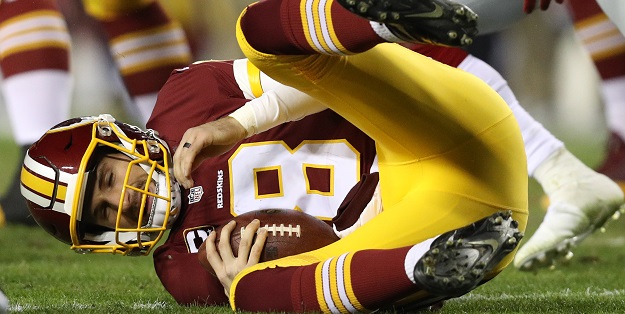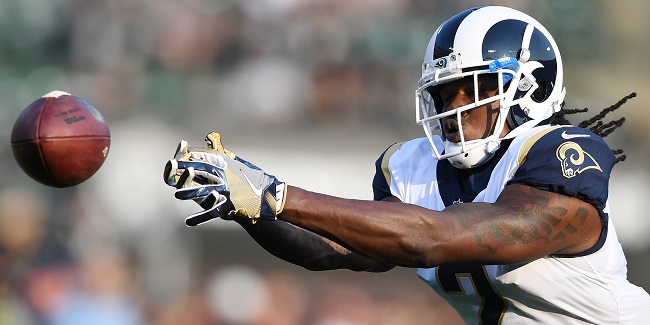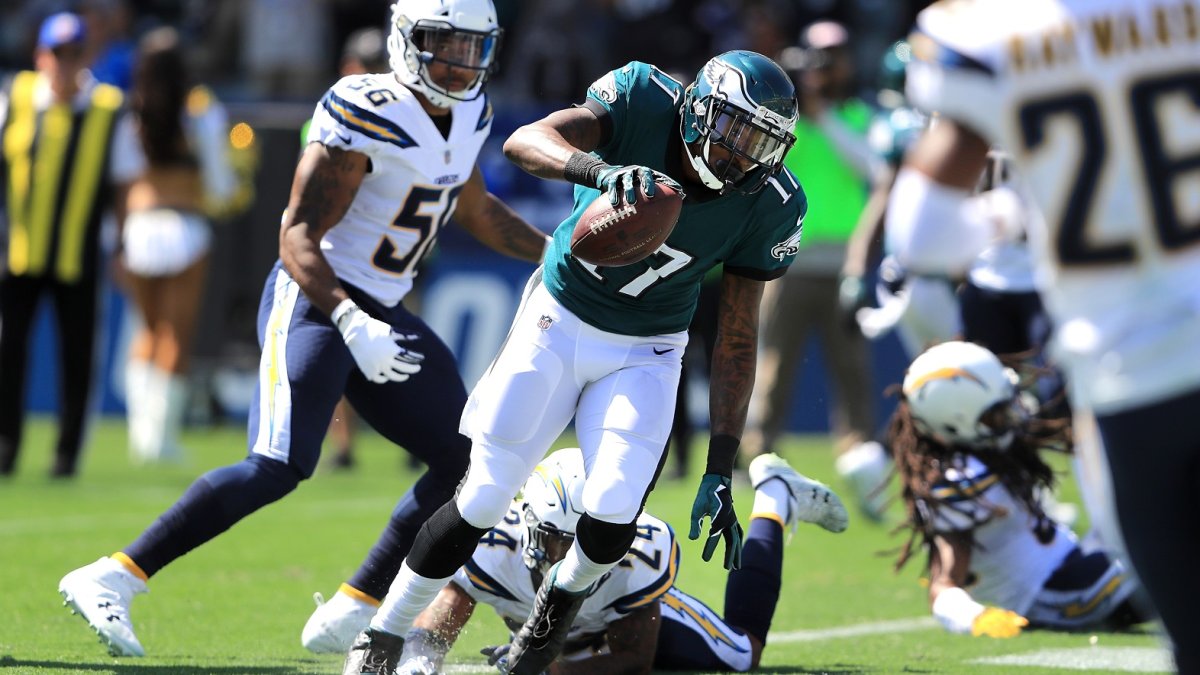We’re nearing the end, of both the NFL season and our fantasy leagues, and the offseason is nearly upon us. With it comes free agency for real-life veterans. Whatever decision they make, it will have an impact on their dynasty value. For some, staying put will keep their value steady or possibly improve it. For others, a chance of scenery would do them (and their dynasty owners) some good. Below are a few of the bigger names who could, or could not, be on the move, along with what would be the best outcome for their dynasty value.
Drew Brees, QB, New Orleans Saints
While it’s hard to imagine Brees playing anywhere else, he still doesn’t have a contract for 2018, which at least opens the possibility of him playing somewhere else. And if he ever does consider playing in a different zip code, Brees continues to play at such a high level that he wouldn’t be short of suitors. For example, his current yards-per-attempt average of 8.1 would be his highest since 2011 and is a full half-yard higher than his career average. He’s also seventh in PFF’s deep-ball accuracy and fifth in its QB rating.
The only real knock on Brees this season is the decline in yards and touchdowns, but that’s through no fault of his own. The Saints are “only” passing the ball 34 times a game, compared to 42 attempts per game last year. He’s on pace for the lowest yards-per-game total since arriving in New Orleans and his touchdown rate of 4.3 percent is nearly a point lower than his career 5.3. However, the Saints are 8-3 and being led by the running back tandem of Mark Ingram and Alvin Kamara, so it's not like they miss Brees passing so much.
Should He Stay or Should He Go: Stay. Despite the reduced yards and touchdowns, he’s still 10th among quarterbacks in fantasy scoring this season. There’s an outside chance he might not have Ingram next year, but he’d be hard pressed to find a better supporting cast than Kamara and receiver Michael Thomas still and has shown no signs of slowing down.
Kirk Cousins, QB, Washington Redskins
Cousins continues to perform well while seeing major turnover among his receiver corps and coaches. At receiver, gone are veterans DeSean Jackson and Pierre Garcon, who were both around for Cousins when he averaged nearly 4,500 passing yards and 27 touchdowns over the last two seasons. Enter Jamison Crowder, who was around for both seasons but has taken on an even bigger role this year, and second-year receiver Josh Doctson, who has been severely behind in playing time but is now healthy and proving to be an asset, ranking 11th in PFF’s wide receiver rating this year. Cousins also has a new offensive coordinator in Matt Cavanaugh after Sean McVay took the head coaching job with the Rams. Cousins hasn’t missed a beat with him either, passing for 276 yards per game — in line with his career 265-per-game average. His touchdown rate of 5.1 percent is also slightly above his career average of 4.7, and his interception rate of 1.6 percent is slightly below his career average of 2.5. He’s currently PFF’s 10th-highest graded quarterback.

Should He Stay or Should He Go: Stay. It’s hard to imagine a scenario where it gets better for Cousins’ dynasty value anywhere else, as he’s currently fantasy’s fourth-highest-scoring quarterback despite the changes in coaches and receivers. One of those possible suitors, San Francisco, is also out of the race after trading for former Patriots quarterback Jimmy Garoppolo, blocking a potential reunion with former Redskins coordinator Kyle Shanahan.
Le’Veon Bell, RB, Pittsburgh Steelers
After failing to sign a long-term deal, the Steelers and Bell will go down to the wire when it comes to the back’s free agency. If Bell becomes available, he’d become the best non-quarterback to test the waters in years. He’s only played a full 16-game season once in his four-year career due to various suspensions and injuries, but when he’s on the field he’s as productive as they come. His career averages include 86 rushing yards per game plus five catches and over 40 yards receiving-per-game.
But could he replicate those kinds of numbers anywhere else? Would anyone else feed him the ball that much? As our own Scott Barrett noted:
Le'Veon Bell is on pace for 455 touches this season. Would be third-most by any player in any season all-time.
— Scott Barrett (@ScottBarrettDFB) November 27, 2017
Should He Stay or Should He Go: Stay. Bell’s been this productive while having continuity in Pittsburgh, a Steeler trait. He’s only played for coach Mike Tomlin and offensive coordinator Todd Haley. It also helps to have one the most productive receivers of our generation, Antonio Brown, to draw defenses away from the line of scrimmage. To go anywhere else would risk upsetting the apple cart for Bell. Even then, unless he went to the handful of teams with elite receivers (i.e. the New York Giants), his dynasty value is better off in Pittsburgh.
Dion Lewis, RB, New England Patriots
Despite an injury-riddled career, Lewis has managed to be quite efficient. He has just 246 carries in his career but rushed for 1,186 yards for 4.8 yards-per-carry average. This year he’s even managed to step it up, averaging 5.1 yards per carry while setting a career-high in carries in a season with 97 and yards with 498. Initially, as always with the Patriots backfield, they attempted to spread the wealth in bringing in free agent running backs Rex Burkhead and Mike Gillislee despite already having Lewis and James White on the roster. At first it was Gillislee leading the backfield, tallying 98 carries to lead New England through Week 13 despite being a healthy scratch every week since Week 8. Lately it’s been Lewis carrying the load, with double-digit carries every week since Week 6. In that time, he’s paid off for fantasy owners, as he’s the 15th-highest-scoring running back and is fifth in points per snap. He’s also got the second-best elusive rating out of the 51 running backs with at least 63 rushes.
Should He Stay or Should He Go: Go. The post-New England track record of leading running backs leaving the Patriots is mixed under Bill Belichick. On one hand, you have a BenJarvus Green-Ellis, who rushed for 1,000 yards in Cincinnati following his departure in 2011. On the other you have Stevan Ridley, who didn’t rush for 100 yards in his entire career after leaving New England. So while Lewis has thrived in New England, he’d be better served on another team where he would have a better chance to see 200 carries.
Jerick McKinnon, RB, Minnesota Vikings
It was just a few years ago that McKinnon was the heir apparent to Adrian Peterson in Minnesota and a highly touted dynasty asset. In his first two seasons, he rushed for 809 yards on only 165 carries, averaging nearly five yards per carry. He also added 48 catches for 308 yards in the passing game, confirming his ability to handle those duties. Then 2016 happened. Peterson got hurt, giving McKinnon his big chance. Yes, he led the team in rushing with 539 yards, but labored through them on 159 carries for 3.4 yards per carry. It explains why the Vikings traded up for Dalvin Cook in this past draft and immediately turned the keys over to him, relegating McKinnon back to the bench.
A torn ACL for Cook has bumped McKinnon back into a more prominent role but he still hasn’t regained the rushing effectiveness of his first two seasons, averaging just 3.7 yards per carry, and only rushing for more than 3.6 yards per carry in a game three times this season. But he still has the receiving chops, sitting at ninth among running backs in yards per route run and is fifth in drop rate.
Should He Stay or Should He Go: Go. McKinnon is much more effective in the passing game, but saw just eight receptions in three games Cook was healthy. His value would increase serving as the passing-down back on a team that passes more than the Vikings. There are currently four running backs in the top 25 in receptions and McKinnon can easily join them on the right team.
Alshon Jeffery, WR, Philadelphia Eagles
Before there was Odell Beckham or Mike Evans at the top of dynasty receiver rankings, there was Jeffery. His 1,421 receiving yards his sophomore season was the fourth-most by a receiver before their age-24 season in league history. He followed that up with another 1,000-yard season before injuries caused Jeffery to play only 21 of a possible 32 games over the next two seasons. He then signed a one-year, prove-it deal with the Eagles to re-establish his value and hit a bigger payday this offseason. And so far, it looks like Jeffery will do just that. He leads the team in targets with 89 and has 43 receptions for 619 yards and seven touchdowns — including five in his past four games — and is fantasy’s 11th-highest-scoring receiver so far. More importantly, he’s been healthy and played in all 11 games so far this season.
Should He Stay or Should He Go: Go. Jeffery has re-established himself as a WR1 but won’t see the same volume in Philadelphia as he would somewhere else. The Eagles are just 23rd in pass attempts per game with 32, whereas the Bears averaged 36 and 38 during Jeffery’s two 1,000-yard seasons in 2013 and 2014. If he can latch on with a more pass-heavy team, it would boost his dynasty value.
Sammy Watkins, WR, Los Angeles Rams
This season has been a disaster for Watkins. After a surprise trade in the preseason, hopes were high for Watkins that he would be able to produce at a level that’s been expected since he entered the league. He’s barely scratched those expectations with one 1,000-yard season and almost another in his rookie season. This season, even though Jared Goff has turned in a Pro Bowl-caliber season, Watkins has barely been seen. He’s caught just 28 balls through 11 games for 490 yards, averaging just 44 yards per game. On his own team, he’s only fourth — fourth! — in receptions and yards. And it’s not like Watkins isn’t producing when given the chance. His PFF wide receiver rating of 121.8 is good for ninth among receivers with at least 30 targets.

Should He Stay or Should He Go: Go. Go as fast as he can. It’s hard to find another team that would de-prioritize Watkins as much as the Rams. And as a free agent, any team that signs him would hopefully plan on targeting more than the 50 times that he’s going to see this season.
Austin Seferian-Jenkins, TE, New York Jets
It’s been a long, strange trip for Seferian-Jenkins. After being taken in the second round of the 2014 draft by Tampa Bay, ASJ was considered a top-five dynasty tight end. But he never cleared 400 receiving yards in his two seasons there before eventually falling out of favor with the new Tampa coaching staff and latching on with the Jets. Things weren’t much better there, as offensive coordinator Chan Gailey targeted Seferian-Jenkins 17 times in the seven games he made appearances with them.
But 2017 has been a different story. Not only did Seferian-Jenkins not have any competition for snaps, but the Jets brought in a more tight end-friendly offensive coordinator in John Morton, who has given Seferian-Jenkins 57 targets, good for third on the team. He currently has 41 catches for 315 yards and three touchdowns and is on pace for career-highs in all of them. Another encouraging sign is his fourth-place ranking in PFF’s drop rate among tight ends with at least 40 targets.
Should He Stay or Should He Go: Go. It appears Seferian-Jenkins is finally becoming a reliable fantasy option and his services should be met with a decent demand from teams looking for a sure-handed receiving tight end. If he does sign with another team, one would assume they have a big role carved out for him.



 © 2024 PFF - all rights reserved.
© 2024 PFF - all rights reserved.